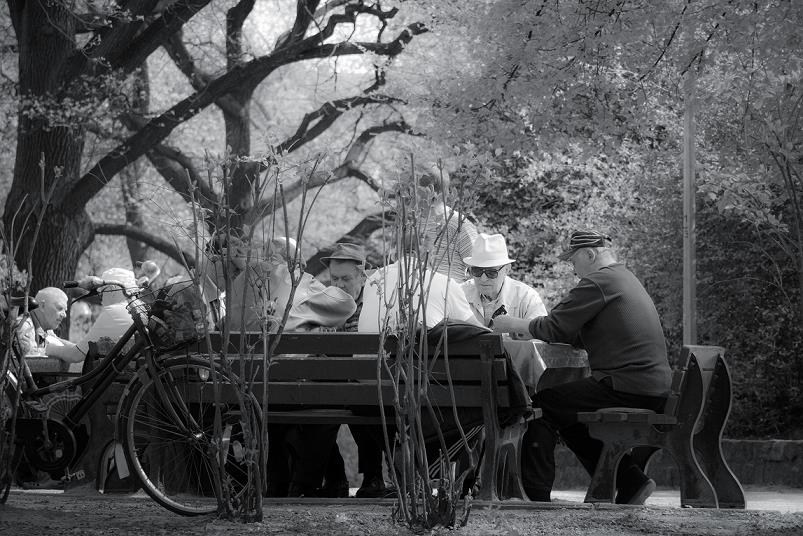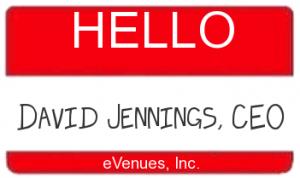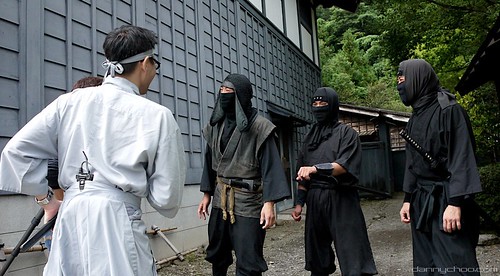In June, we reached out to some of the best and brightest in the meetings industry to get their input on the best career advice they had ever received (or had learned the hard way). Considering how well that post was received and also considering that 2012 is coming to a close, we thought we'd reach out again to get their 2013 predictions.
Behold! Here are their predictions:
Venues will focus more on "local" flavor
 "In MPI's future of meetings research, architect Robert Hopkins says, 'Flexibility is often badly interpreted as sliding and folding walls where spaces attempt to do many things badly. The key is to be more specific.' We see venues becoming more and more specific in terms of their time and place.
"In MPI's future of meetings research, architect Robert Hopkins says, 'Flexibility is often badly interpreted as sliding and folding walls where spaces attempt to do many things badly. The key is to be more specific.' We see venues becoming more and more specific in terms of their time and place.
We'll see fewer isolated and cookie-cutter institutions, and more venues that embrace their place—from design of space to décor. They'll "go local" by featuring local materials, local foods, local artists, local icons and local talent. Meanwhile, delegate needs are changing. They want more peer interaction and learning and less lecture time, and meeting professionals are relying on their suppliers to provide spaces for these kind of experiences."
--Jessie States, Editor, meeting industry at Meeting Professionals International
More generous budgets and quicker turnarounds
 "I believe we'll start to see wider booking windows for corporate events, with more generous budgets and quicker turnaround with decisions and commitments. With so many online booking tools and mobile apps, planners will continue to be more tech savvy and web-based when researching and sourcing their meetings, but there will still be a strong demand for customer service and planner/supplier relationships that will ultimately secure the business."
"I believe we'll start to see wider booking windows for corporate events, with more generous budgets and quicker turnaround with decisions and commitments. With so many online booking tools and mobile apps, planners will continue to be more tech savvy and web-based when researching and sourcing their meetings, but there will still be a strong demand for customer service and planner/supplier relationships that will ultimately secure the business."
--Lisa Kraus, Director of Business Development & Events for Plan Your Meetings
2013 is the year for planners to start thinking about sustainability
 "The meetings industry is impacted by several global sustainability trends. Food prices have increased over 6% in 2012, and are expected to continue to rise in 2013. Climatic events present risks as well, increasing pressure on companies to manage and reduce their carbon footprint, in addition to having a response plan to emergency situations.
"The meetings industry is impacted by several global sustainability trends. Food prices have increased over 6% in 2012, and are expected to continue to rise in 2013. Climatic events present risks as well, increasing pressure on companies to manage and reduce their carbon footprint, in addition to having a response plan to emergency situations.
Fortifying ourselves to be resilient to these issues will be a key challenge, and opportunity for innovation. Solutions include taking practical steps to reduce food waste, control portion size, and promote healthier alternatives on event menus. Planning to measure and reduce event carbon by 5% per year is also critical, so think practically about how your property uses energy, how much air travel is necessary, and where footprint can be reduced. This includes embracing the trend toward hybrid meetings."
--Shawna McKinley, Director of Sustainability at MeetGreen
2013: upping the ante for online social engagement
 "2013 is all about upping the ante for online social engagement ROI that transfers back to the real world and for businesses to actually reap the results of their marketing efforts. We will see experiential incentives like Viggle and social incentive sharing platforms like Expect Referrals and tools in all types of markets become more prevalent and cross over into the meeting and event industries. Foursquare and Instagram will also integrate into events with wide spread force and will evolve into more ROE (Return on Experience) for event planners and marketers. Social curation utilizing visual platforms like Pinterest and Loveit will remain hot and will transition into a must need tool in the event industry. The help of these visual boards allow #eventprofs to transfer ideas more visually and get real time feedback from clients to gain better synergy."
"2013 is all about upping the ante for online social engagement ROI that transfers back to the real world and for businesses to actually reap the results of their marketing efforts. We will see experiential incentives like Viggle and social incentive sharing platforms like Expect Referrals and tools in all types of markets become more prevalent and cross over into the meeting and event industries. Foursquare and Instagram will also integrate into events with wide spread force and will evolve into more ROE (Return on Experience) for event planners and marketers. Social curation utilizing visual platforms like Pinterest and Loveit will remain hot and will transition into a must need tool in the event industry. The help of these visual boards allow #eventprofs to transfer ideas more visually and get real time feedback from clients to gain better synergy."
--Michelle Bergstein Fontanez, Marketing Maven Event Industry Marketing by BeatCreative
Still scaling back on event budgets
 " I think 2013 will see the industry staying as is or a very slow increase in the industry – with the outcome of the 2012 election we continuing to see layoffs in many industries. This slower economy will continue to negatively impact growth in the meetings and events industry. My global clients say that the US economy has an impact on all of their business globally, and that other regions of the world have slowing economies. When the economy is down it impacts our industry as for many meetings and event are deemed to be a luxury. My clients that are not cutting events have continued to scale back the event budget."
" I think 2013 will see the industry staying as is or a very slow increase in the industry – with the outcome of the 2012 election we continuing to see layoffs in many industries. This slower economy will continue to negatively impact growth in the meetings and events industry. My global clients say that the US economy has an impact on all of their business globally, and that other regions of the world have slowing economies. When the economy is down it impacts our industry as for many meetings and event are deemed to be a luxury. My clients that are not cutting events have continued to scale back the event budget."
--Julie Ann Schmidt, Managing Partner at Lithium Logistics Group. (LinkedIn Profile).
Social media and technology is allowing for 3 BIG changes
 "Looking at how social media is evolving to support the business needs of the meetings & event industry, we clearly see three specific trends that have gained significant momentum in 2012 with full expectation of even more in 2013:
"Looking at how social media is evolving to support the business needs of the meetings & event industry, we clearly see three specific trends that have gained significant momentum in 2012 with full expectation of even more in 2013:
1. Increased use and power of peer networking over traditional informational databases: Social media driving a shift in the primary source of supplier and destination information from traditional supplier-provided databases to peer references, informational blogs, and experiential webcasts/videos.
2. Event Life Extension: The value and life of an event has moved well beyond the dates of the actual event. Social media makes it possible to build collaborative and engaging communities for attendees both pre and post event dates to richly expand the life and influence of a single event.
3. The beginning of the end of the RFP: Information gathering, supplier services evaluation, and reputation checking have moved into the social media arena which circumvents traditional RFP processing. Buyers have access to richer, deeper sources of information to make decisions without having to go the historical route of engaging the supplier UNTIL they are ready to buy. This is changing the way suppliers create and nurture relationships that drive actual business."
--Mike Malinchok, Vice President of Strategic Partnerships at i-meet.com.
Online engagement skills will be no longer optional
 "Online engagement skills will transition from being delegated to the youngest person at an organization to being expected of every professional. Suppliers who have established a personal brand and are comfortable building relationships online will be more successful. Meeting planners are being asked to incorporate online elements into all aspects of their meetings (virtual/hybrid, mobile apps, social media) and the ones who have practiced the art of the online relationship will be much better equipped."
"Online engagement skills will transition from being delegated to the youngest person at an organization to being expected of every professional. Suppliers who have established a personal brand and are comfortable building relationships online will be more successful. Meeting planners are being asked to incorporate online elements into all aspects of their meetings (virtual/hybrid, mobile apps, social media) and the ones who have practiced the art of the online relationship will be much better equipped."
--Elizabeth Glau CMP, Owner, Chief Foundation Strategist at Building Blocks Social Media.
Tight budgets, smarter social media, and a tougher job for the planner
 "Prediction #1: Budgets will stay tight in 2013, leading to more SMMP development and implementation in corporations, more procurement involvement involvement in meetings, more short lead times, continued emphasis on cutting costs, possibly more local/regional meetings, unique venues.
"Prediction #1: Budgets will stay tight in 2013, leading to more SMMP development and implementation in corporations, more procurement involvement involvement in meetings, more short lead times, continued emphasis on cutting costs, possibly more local/regional meetings, unique venues.
Prediction #2: More and smarter use of social media to not just promote events/meetings, but also to engage participants before, during, and after an event.
Prediction #3: Hotel and air rates look to continue to rise, and we can expect both to find new and creative things to charge a fee for. Planners will have to work harder than ever to provide compelling reasons to pay increasing costs to attend. Will that lead to better, more engaging, interactive, wow-inducing meetings? I sure hope so!"
--Sue Pelletier, Editor of Medical Meetings, a MeetingsNet Magazine.
Digital extensions of face-to-face events will accelerate
 "The industry's adoption of technology, particularly the digital extension of face to face events, will accelerate. Those extensions in aggregate will drive stronger attendance at market facing events.
"The industry's adoption of technology, particularly the digital extension of face to face events, will accelerate. Those extensions in aggregate will drive stronger attendance at market facing events.
More importantly, our smarter and smarter utilization of technology available to us will also become evident."
--Tony Lorenz, Founder at bxbOnline.
More content marketing, more virtual meetings, and more hybrid events
 "As a result of my experience marketing my Icon Presentations blog, I have become very involved as a blogger, presenter and consultant on Social Media Strategy and Content Marketing.
"As a result of my experience marketing my Icon Presentations blog, I have become very involved as a blogger, presenter and consultant on Social Media Strategy and Content Marketing.
1 - With the advent of content marketing and the plethora of tools for dispersing a message and engaging with attendees online, the importance of quality content creation will gain a renewed focus among event planners. Planners will begin to realize the value of capturing conference content and dispersing it in an easily digestible way with the goal of increasing the value of events and marketing them online throughout the year.
2 - Meeting planners will adjust to the fact that many face to face meetings are no longer necessary due to the ease with which multiple parties can now meet online. They will begin to take more of a lead in mastering the skills needed to organize virtual meetings and more and more face to face meetings will feature experiences that cannot be duplicated in a virtual context.
3 - You will see more targeted use of hybrid event experiences: for instance, streaming only certain sessions and offering an online Q &A with the speaker afterward; separate virtual tracks targeted to the audience that couldn't attend in person; streamed sessions lasting 10 to 20 minutes at the most geared toward the easily distracted remote attendee. "
--Jenise Fryatt, Co-Owner and Director of Icon Presentations
Gen X and Gen Y will take over
 "I believe one of the biggest trends to affect the meetings industry in 2013 will be the accelerating shift in demographics, as more and more boomers retire and Gen X and Gen Y take over. It's a trend I've written about earlier this fall.
"I believe one of the biggest trends to affect the meetings industry in 2013 will be the accelerating shift in demographics, as more and more boomers retire and Gen X and Gen Y take over. It's a trend I've written about earlier this fall.
With this will come a fundamental shift in how organizations regard meetings. Younger generations want more information about the purpose of meetings (unlike boomers who often were happy to meet for the sake of meetings). They are more protective of their private time and will resent meetings being scheduled on weekends or taking them away for extended periods. Of course younger generations will continue to bring mobile technology and social meeting into meeting rooms, forcing planners to accommodate them with free WiFi and opportunities to share and engage. Finally because of the increased used of social media, and the inherent multi-tasking this brings about, younger generations will look for agendas with more frequent breaks and more dynamic presentation styles."
--Doreen Ashton Wagner, Chief Strategist at Greenfield Services and The Meeting & Event LEAD Blog.
Meetings are becoming more unique
 "One important new trend we are seeing in meetings is delivering content in new and different ways, whether it’s through CSR and teambuilding activities, TED formats, or the use of technology and social media to engage attendees before, during and after the conference. As a convention and visitors bureau, we are being called upon more often to assist planners in suggesting unique activities – such as for the Pacific Tree Climbing Institute or Iron Chef Competitions – as well as to add lift to the conference’s social media channels. This has become so important, in fact, that we recently added a complimentary Social Media Toolkit for Planners as a download on our website."
"One important new trend we are seeing in meetings is delivering content in new and different ways, whether it’s through CSR and teambuilding activities, TED formats, or the use of technology and social media to engage attendees before, during and after the conference. As a convention and visitors bureau, we are being called upon more often to assist planners in suggesting unique activities – such as for the Pacific Tree Climbing Institute or Iron Chef Competitions – as well as to add lift to the conference’s social media channels. This has become so important, in fact, that we recently added a complimentary Social Media Toolkit for Planners as a download on our website."
--Janis Ross CMP MBA, Vice President of Convention & Sports Marketing at Eugene Cascades Coast.
2013 will Be a year of growth
 "I believe 2013 will be a good year for the meetings industry. Now that the Presidential election is over, businesses will get back to focusing on sales and growth and meetings are necessary to accomplish such. Company executives are now looking back and seeing that several years of budget cuts on meetings may have helped with incremental improvements in their bottom lines but did nothing to improve top line sales growth."
"I believe 2013 will be a good year for the meetings industry. Now that the Presidential election is over, businesses will get back to focusing on sales and growth and meetings are necessary to accomplish such. Company executives are now looking back and seeing that several years of budget cuts on meetings may have helped with incremental improvements in their bottom lines but did nothing to improve top line sales growth."
--Randall Whatley, President at Cypress Media Group
Social media has hit prime time
 "Social Media integration seems to have hit prime time this year. Caterers that I work with have all moved to having in house folks working on their social media campaigns or at least making sure they set up a Facebook page. In 2011 people were skeptical, in 2012 they thought it was necessary and in 2013 they will be looking to maximize presence.
"Social Media integration seems to have hit prime time this year. Caterers that I work with have all moved to having in house folks working on their social media campaigns or at least making sure they set up a Facebook page. In 2011 people were skeptical, in 2012 they thought it was necessary and in 2013 they will be looking to maximize presence.
Email marketing is still effective but the power of social is still growing and I think we will see many more tools that utilize technology in 2013. As we become more connected and information is more easily attainable we will see lower cost web events aimed at wider audiences to utilize the power of volume. On the same note we will see large conferences shrinking to 'hyper target' qualified buyers for their sponsors and main stake holders."
--Cameron Toth, Owner at Toth Event Staffing
More mobile apps
 "I think that the biggest trend that we will see widespread is the use of mobile applications. More and more, planners are implementing mobile apps into their events. Because there are so many great providers out there, organizations no longer need to develop apps from scratch. They can simply go out to the market and find an app that has features That meet the needs of their attendees. Attendees are starting to expect quick access to information and a high level of engagement and the majority are carrying smartphones making the adoption of mobile event apps easier. "
"I think that the biggest trend that we will see widespread is the use of mobile applications. More and more, planners are implementing mobile apps into their events. Because there are so many great providers out there, organizations no longer need to develop apps from scratch. They can simply go out to the market and find an app that has features That meet the needs of their attendees. Attendees are starting to expect quick access to information and a high level of engagement and the majority are carrying smartphones making the adoption of mobile event apps easier. "
--Jessica Levin MBA CMP, President at Seven Degrees Communications
Meetings technology will become cheaper and easier to use
 "This trend in software programming is driven by continued advances in web services and open-source technology. This makes it easier, cheaper and faster to create, distribute and use technology to help in meeting planning. There are hundreds of free, freemium, low cost, and do-it-yourself (DIY) options providing lower costs and more flexibility for planners. Examples include ContantContact’s new Online Event Registration starting at $20/month, a small fraction of typical online registration costs. Guidebook offers a free meeting DIY mobile guide app with up to 500 downloads per event. Google Hangouts On Air offers free multipoint video conferencing, steaming and recording. Joomla provides free web site building and content management tools with over 9,000 plugins. …just to name a few! These forces are also driving mobile app development with hundreds of thousands for free or very low cost app available; many of them of great help to meeting professionals."
"This trend in software programming is driven by continued advances in web services and open-source technology. This makes it easier, cheaper and faster to create, distribute and use technology to help in meeting planning. There are hundreds of free, freemium, low cost, and do-it-yourself (DIY) options providing lower costs and more flexibility for planners. Examples include ContantContact’s new Online Event Registration starting at $20/month, a small fraction of typical online registration costs. Guidebook offers a free meeting DIY mobile guide app with up to 500 downloads per event. Google Hangouts On Air offers free multipoint video conferencing, steaming and recording. Joomla provides free web site building and content management tools with over 9,000 plugins. …just to name a few! These forces are also driving mobile app development with hundreds of thousands for free or very low cost app available; many of them of great help to meeting professionals."
Above quote used with permission from an article on Corbin Ball's Website.
--Corbin Ball CSP CMP, Owner at Corbin Ball Associates.
Short term requests and bookings will continue
 "I believe 2013 will continue the trend of short term requests and bookings as our industry continues to be responsive and reactive to creating meaningful meetings and fantastic events. I look forward to seeing how the changes in social media and technology affect our event planning, execution and ultimately the guest experience from marketing to evaluation, and all the touch-points in between. I believe this is something that will be affected partly by generation and adoption phase of both Planner and Participant. 2013 will be a year of evolution, globally and in North America as clients who understand the power of face-to-face meetings, incentive travel and responsible fundraising respond to the economic realities that we are in."
"I believe 2013 will continue the trend of short term requests and bookings as our industry continues to be responsive and reactive to creating meaningful meetings and fantastic events. I look forward to seeing how the changes in social media and technology affect our event planning, execution and ultimately the guest experience from marketing to evaluation, and all the touch-points in between. I believe this is something that will be affected partly by generation and adoption phase of both Planner and Participant. 2013 will be a year of evolution, globally and in North America as clients who understand the power of face-to-face meetings, incentive travel and responsible fundraising respond to the economic realities that we are in."
--Tahira Endean CMP, Director - Creative and Production at Cantrav and Blogger at Events, Life and Impact Points
App 2.0 should be pursued for meetings and events
 "In 2013, I'd like to see the meeting industry (e.g. meeting planners, in conjunction with technology vendors and providers) pursue App 2.0 for meetings and events. While App 1.0 was successful in providing the basics (session and exhibitor listings, social media integration, some degree of profile matchmaking), App 2.0 goes deeper to enable our mobile devices to be a more valuable and trusted "partner" to make the most of our meeting experience. What does that mean? That's for the industry to determine."
"In 2013, I'd like to see the meeting industry (e.g. meeting planners, in conjunction with technology vendors and providers) pursue App 2.0 for meetings and events. While App 1.0 was successful in providing the basics (session and exhibitor listings, social media integration, some degree of profile matchmaking), App 2.0 goes deeper to enable our mobile devices to be a more valuable and trusted "partner" to make the most of our meeting experience. What does that mean? That's for the industry to determine."
--Dennis Shiao, Director of Product Marketing at INXPO and blogger at It's All Virtual
Jobs will continue to be more niche oriented
 "Social media seems to be the 'go-to' place for networking and making contacts. Personal branding (knowing who you are, what you do and what differentiate yourself from others) is an important step in 2013. It sets you apart from the rest of the pack internally within your organization and externally if you are searching for the next opportunity. Jobs continue to be niche oriented. Medical companies wanting medical meeting planners, financial companies wanting financial planners, associations seeking association planners. Specialties within the niches also have become important."
"Social media seems to be the 'go-to' place for networking and making contacts. Personal branding (knowing who you are, what you do and what differentiate yourself from others) is an important step in 2013. It sets you apart from the rest of the pack internally within your organization and externally if you are searching for the next opportunity. Jobs continue to be niche oriented. Medical companies wanting medical meeting planners, financial companies wanting financial planners, associations seeking association planners. Specialties within the niches also have become important."
--Dawn Penfold CMP, President at Meetingjobs
The industry needs to focus on transparency and ethics
 "In 2013 our industry will need to focus increasingly on transparency and ethics. These are multi-faceted issues, and incorporate everything from ethical bid processes, to the social and environmental impact of our events, to intellectual property in a social media age and to acceptable elements in our events within the global economic context. We've made great progress in recent years in being able to articulate the business value of meetings, and we need to ensure that our actions and professionalism as an industry support the delivery of this message."
"In 2013 our industry will need to focus increasingly on transparency and ethics. These are multi-faceted issues, and incorporate everything from ethical bid processes, to the social and environmental impact of our events, to intellectual property in a social media age and to acceptable elements in our events within the global economic context. We've made great progress in recent years in being able to articulate the business value of meetings, and we need to ensure that our actions and professionalism as an industry support the delivery of this message."
--Mariela McIlwraith CMP CMM MBA, President at Meeting Change
Content (marketing) is king
 "This year has been the year of "content marketing" as organizers start to see the value of promoting the true value of their content rather than relying on the old tried and tested marketing messages. In 2013 content marketing will continue to help the good events differentiate themselves from the bad and the down right ugly. "
"This year has been the year of "content marketing" as organizers start to see the value of promoting the true value of their content rather than relying on the old tried and tested marketing messages. In 2013 content marketing will continue to help the good events differentiate themselves from the bad and the down right ugly. "
--William Thomson, Head Honcho at Gallus Events

 Personalization is in. In 2014, Coca-Cola took the 250 most popular names in the United States and put one at random on individual cans and bottles of their product. According to The Wall Street Journal, this campaign was responsible for reversing a decade long decline in US Coke consumption.
Put simply, people like to know it’s all about them. But how do you use personalization to your advantage when you’re planning your meeting?
Tagging It
Take a look at the ubiquitous name-tag. Obviously, you want to provide a pre-printed name-tag for all your registered meeting attendees. And surely, we do not need to remind everyone that the name-tag and all other materials should be in a clear font (put away the script and Old English fonts for another time) and in a type size that does not require binoculars to read.
But what name goes on the tag? Take Josiah Pickford Wellington III, who just happens to go by “Trey.†Do you put his legal name on his name-tag? All his friends and business associates knew him as Trey. Regardless of what name he used on his registration paperwork, which name should appear on his pre-printed name-tag? And shouldn’t he, and not the clerical person preparing the name-tags, be the one who chooses what he’s called?
And what else goes on the name-tag? With some planning from the registration materials, you could determine what the attendee would like to publicize. For example, would he like his email address to be visible? His Twitter handle? The name of the product he is promoting? Or, at the cat fanciers’ convention, a picture of his beloved, pure-bred Persian cat? If you can add information that makes the attendee feel more connected at the conference, isn’t it worth it to you to go that extra mile to discover and share these details?
More Sophisticated Identifiers
Don’t forget the other personalization options you might want to make available at the conference itself. At an extended family reunion, perhaps stickers might be available to identify what state the attendee hails from, or a badge might identify what line of the family tree she is descended from. This would create an instant place to start conversations as the participant meets far-flung relatives. At a large company meeting, perhaps a ribbon identifies whether the participant specializes in the manufacturing side or the sales side of the business. This would allow similarly affiliated attendees to easily find people who share their interests.
Strategically Designing Your Event
There are more ways to personalize an event experience beyond customizing identifiers. For instance:
Personalization is in. In 2014, Coca-Cola took the 250 most popular names in the United States and put one at random on individual cans and bottles of their product. According to The Wall Street Journal, this campaign was responsible for reversing a decade long decline in US Coke consumption.
Put simply, people like to know it’s all about them. But how do you use personalization to your advantage when you’re planning your meeting?
Tagging It
Take a look at the ubiquitous name-tag. Obviously, you want to provide a pre-printed name-tag for all your registered meeting attendees. And surely, we do not need to remind everyone that the name-tag and all other materials should be in a clear font (put away the script and Old English fonts for another time) and in a type size that does not require binoculars to read.
But what name goes on the tag? Take Josiah Pickford Wellington III, who just happens to go by “Trey.†Do you put his legal name on his name-tag? All his friends and business associates knew him as Trey. Regardless of what name he used on his registration paperwork, which name should appear on his pre-printed name-tag? And shouldn’t he, and not the clerical person preparing the name-tags, be the one who chooses what he’s called?
And what else goes on the name-tag? With some planning from the registration materials, you could determine what the attendee would like to publicize. For example, would he like his email address to be visible? His Twitter handle? The name of the product he is promoting? Or, at the cat fanciers’ convention, a picture of his beloved, pure-bred Persian cat? If you can add information that makes the attendee feel more connected at the conference, isn’t it worth it to you to go that extra mile to discover and share these details?
More Sophisticated Identifiers
Don’t forget the other personalization options you might want to make available at the conference itself. At an extended family reunion, perhaps stickers might be available to identify what state the attendee hails from, or a badge might identify what line of the family tree she is descended from. This would create an instant place to start conversations as the participant meets far-flung relatives. At a large company meeting, perhaps a ribbon identifies whether the participant specializes in the manufacturing side or the sales side of the business. This would allow similarly affiliated attendees to easily find people who share their interests.
Strategically Designing Your Event
There are more ways to personalize an event experience beyond customizing identifiers. For instance:
 "In MPI's future of meetings research, architect Robert Hopkins says, 'Flexibility is often badly interpreted as sliding and folding walls where spaces attempt to do many things badly. The key is to be more specific.' We see venues becoming more and more specific in terms of their time and place.
"In MPI's future of meetings research, architect Robert Hopkins says, 'Flexibility is often badly interpreted as sliding and folding walls where spaces attempt to do many things badly. The key is to be more specific.' We see venues becoming more and more specific in terms of their time and place. "I believe we'll start to see wider booking windows for corporate events, with more generous budgets and quicker turnaround with decisions and commitments. With so many online booking tools and mobile apps, planners will continue to be more tech savvy and web-based when researching and sourcing their meetings, but there will still be a strong demand for customer service and planner/supplier relationships that will ultimately secure the business."
"I believe we'll start to see wider booking windows for corporate events, with more generous budgets and quicker turnaround with decisions and commitments. With so many online booking tools and mobile apps, planners will continue to be more tech savvy and web-based when researching and sourcing their meetings, but there will still be a strong demand for customer service and planner/supplier relationships that will ultimately secure the business." "The meetings industry is impacted by several global sustainability trends. Food prices have increased over 6% in 2012, and are expected to continue to rise in 2013. Climatic events present risks as well, increasing pressure on companies to manage and reduce their carbon footprint, in addition to having a response plan to emergency situations.
"The meetings industry is impacted by several global sustainability trends. Food prices have increased over 6% in 2012, and are expected to continue to rise in 2013. Climatic events present risks as well, increasing pressure on companies to manage and reduce their carbon footprint, in addition to having a response plan to emergency situations. "2013 is all about upping the ante for online social engagement ROI that transfers back to the real world and for businesses to actually reap the results of their marketing efforts. We will see experiential incentives like
"2013 is all about upping the ante for online social engagement ROI that transfers back to the real world and for businesses to actually reap the results of their marketing efforts. We will see experiential incentives like  " I think 2013 will see the industry staying as is or a very slow increase in the industry – with the outcome of the 2012 election we continuing to see layoffs in many industries. This slower economy will continue to negatively impact growth in the meetings and events industry. My global clients say that the US economy has an impact on all of their business globally, and that other regions of the world have slowing economies. When the economy is down it impacts our industry as for many meetings and event are deemed to be a luxury. My clients that are not cutting events have continued to scale back the event budget."
" I think 2013 will see the industry staying as is or a very slow increase in the industry – with the outcome of the 2012 election we continuing to see layoffs in many industries. This slower economy will continue to negatively impact growth in the meetings and events industry. My global clients say that the US economy has an impact on all of their business globally, and that other regions of the world have slowing economies. When the economy is down it impacts our industry as for many meetings and event are deemed to be a luxury. My clients that are not cutting events have continued to scale back the event budget." "Looking at how social media is evolving to support the business needs of the meetings & event industry, we clearly see three specific trends that have gained significant momentum in 2012 with full expectation of even more in 2013:
"Looking at how social media is evolving to support the business needs of the meetings & event industry, we clearly see three specific trends that have gained significant momentum in 2012 with full expectation of even more in 2013: "Online engagement skills will transition from being delegated to the youngest person at an organization to being expected of every professional. Suppliers who have established a personal brand and are comfortable building relationships online will be more successful. Meeting planners are being asked to incorporate online elements into all aspects of their meetings (virtual/hybrid, mobile apps, social media) and the ones who have practiced the art of the online relationship will be much better equipped."
"Online engagement skills will transition from being delegated to the youngest person at an organization to being expected of every professional. Suppliers who have established a personal brand and are comfortable building relationships online will be more successful. Meeting planners are being asked to incorporate online elements into all aspects of their meetings (virtual/hybrid, mobile apps, social media) and the ones who have practiced the art of the online relationship will be much better equipped." "Prediction #1: Budgets will stay tight in 2013, leading to more SMMP development and implementation in corporations, more procurement involvement involvement in meetings, more short lead times, continued emphasis on cutting costs, possibly more local/regional meetings, unique venues.
"Prediction #1: Budgets will stay tight in 2013, leading to more SMMP development and implementation in corporations, more procurement involvement involvement in meetings, more short lead times, continued emphasis on cutting costs, possibly more local/regional meetings, unique venues. "The industry's adoption of technology, particularly the digital extension of face to face events, will accelerate. Those extensions in aggregate will drive stronger attendance at market facing events.
"The industry's adoption of technology, particularly the digital extension of face to face events, will accelerate. Those extensions in aggregate will drive stronger attendance at market facing events. "As a result of my experience marketing my
"As a result of my experience marketing my  "I believe one of the biggest trends to affect the meetings industry in 2013 will be the accelerating shift in demographics, as more and more boomers retire and Gen X and Gen Y take over. It's a trend
"I believe one of the biggest trends to affect the meetings industry in 2013 will be the accelerating shift in demographics, as more and more boomers retire and Gen X and Gen Y take over. It's a trend  "One important new trend we are seeing in meetings is delivering content in new and different ways, whether it’s through CSR and teambuilding activities, TED formats, or the use of technology and social media to engage attendees before, during and after the conference. As a convention and visitors bureau, we are being called upon more often to assist planners in suggesting unique activities – such as for the
"One important new trend we are seeing in meetings is delivering content in new and different ways, whether it’s through CSR and teambuilding activities, TED formats, or the use of technology and social media to engage attendees before, during and after the conference. As a convention and visitors bureau, we are being called upon more often to assist planners in suggesting unique activities – such as for the  "I believe 2013 will be a good year for the meetings industry. Now that the Presidential election is over, businesses will get back to focusing on sales and growth and meetings are necessary to accomplish such. Company executives are now looking back and seeing that several years of budget cuts on meetings may have helped with incremental improvements in their bottom lines but did nothing to improve top line sales growth."
"I believe 2013 will be a good year for the meetings industry. Now that the Presidential election is over, businesses will get back to focusing on sales and growth and meetings are necessary to accomplish such. Company executives are now looking back and seeing that several years of budget cuts on meetings may have helped with incremental improvements in their bottom lines but did nothing to improve top line sales growth." "Social Media integration seems to have hit prime time this year. Caterers that I work with have all moved to having in house folks working on their social media campaigns or at least making sure they set up a Facebook page. In 2011 people were skeptical, in 2012 they thought it was necessary and in 2013 they will be looking to maximize presence.
"Social Media integration seems to have hit prime time this year. Caterers that I work with have all moved to having in house folks working on their social media campaigns or at least making sure they set up a Facebook page. In 2011 people were skeptical, in 2012 they thought it was necessary and in 2013 they will be looking to maximize presence. "I think that the biggest trend that we will see widespread is the use of mobile applications. More and more, planners are implementing mobile apps into their events. Because there are so many great providers out there, organizations no longer need to develop apps from scratch. They can simply go out to the market and find an app that has features That meet the needs of their attendees. Attendees are starting to expect quick access to information and a high level of engagement and the majority are carrying smartphones making the adoption of mobile event apps easier. "
"I think that the biggest trend that we will see widespread is the use of mobile applications. More and more, planners are implementing mobile apps into their events. Because there are so many great providers out there, organizations no longer need to develop apps from scratch. They can simply go out to the market and find an app that has features That meet the needs of their attendees. Attendees are starting to expect quick access to information and a high level of engagement and the majority are carrying smartphones making the adoption of mobile event apps easier. " "This trend in software programming is driven by continued advances in
"This trend in software programming is driven by continued advances in  "I believe 2013 will continue the trend of short term requests and bookings as our industry continues to be responsive and reactive to creating meaningful meetings and fantastic events. I look forward to seeing how the changes in social media and technology affect our event planning, execution and ultimately the guest experience from marketing to evaluation, and all the touch-points in between. I believe this is something that will be affected partly by generation and adoption phase of both Planner and Participant. 2013 will be a year of evolution, globally and in North America as clients who understand the power of face-to-face meetings, incentive travel and responsible fundraising respond to the economic realities that we are in."
"I believe 2013 will continue the trend of short term requests and bookings as our industry continues to be responsive and reactive to creating meaningful meetings and fantastic events. I look forward to seeing how the changes in social media and technology affect our event planning, execution and ultimately the guest experience from marketing to evaluation, and all the touch-points in between. I believe this is something that will be affected partly by generation and adoption phase of both Planner and Participant. 2013 will be a year of evolution, globally and in North America as clients who understand the power of face-to-face meetings, incentive travel and responsible fundraising respond to the economic realities that we are in." "In 2013, I'd like to see the meeting industry (e.g. meeting planners, in conjunction with technology vendors and providers) pursue App 2.0 for meetings and events. While App 1.0 was successful in providing the basics (session and exhibitor listings, social media integration, some degree of profile matchmaking), App 2.0 goes deeper to enable our mobile devices to be a more valuable and trusted "partner" to make the most of our meeting experience. What does that mean? That's for the industry to determine."
"In 2013, I'd like to see the meeting industry (e.g. meeting planners, in conjunction with technology vendors and providers) pursue App 2.0 for meetings and events. While App 1.0 was successful in providing the basics (session and exhibitor listings, social media integration, some degree of profile matchmaking), App 2.0 goes deeper to enable our mobile devices to be a more valuable and trusted "partner" to make the most of our meeting experience. What does that mean? That's for the industry to determine." "Social media seems to be the 'go-to' place for networking and making contacts. Personal branding (knowing who you are, what you do and what differentiate yourself from others) is an important step in 2013. It sets you apart from the rest of the pack internally within your organization and externally if you are searching for the next opportunity. Jobs continue to be niche oriented. Medical companies wanting medical meeting planners, financial companies wanting financial planners, associations seeking association planners. Specialties within the niches also have become important."
"Social media seems to be the 'go-to' place for networking and making contacts. Personal branding (knowing who you are, what you do and what differentiate yourself from others) is an important step in 2013. It sets you apart from the rest of the pack internally within your organization and externally if you are searching for the next opportunity. Jobs continue to be niche oriented. Medical companies wanting medical meeting planners, financial companies wanting financial planners, associations seeking association planners. Specialties within the niches also have become important." "In 2013 our industry will need to focus increasingly on transparency and ethics. These are multi-faceted issues, and incorporate everything from ethical bid processes, to the social and environmental impact of our events, to intellectual property in a social media age and to acceptable elements in our events within the global economic context. We've made great progress in recent years in being able to articulate the business value of meetings, and we need to ensure that our actions and professionalism as an industry support the delivery of this message."
"In 2013 our industry will need to focus increasingly on transparency and ethics. These are multi-faceted issues, and incorporate everything from ethical bid processes, to the social and environmental impact of our events, to intellectual property in a social media age and to acceptable elements in our events within the global economic context. We've made great progress in recent years in being able to articulate the business value of meetings, and we need to ensure that our actions and professionalism as an industry support the delivery of this message." "This year has been the year of "content marketing" as organizers start to see the value of promoting the true value of their content rather than relying on the old tried and tested marketing messages. In 2013 content marketing will continue to help the good events differentiate themselves from the bad and the down right ugly. "
"This year has been the year of "content marketing" as organizers start to see the value of promoting the true value of their content rather than relying on the old tried and tested marketing messages. In 2013 content marketing will continue to help the good events differentiate themselves from the bad and the down right ugly. "